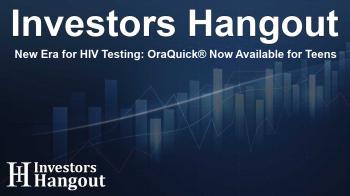New Era for HIV Testing: OraQuick® Now Available for Teens

Increased Accessibility of HIV Testing for Adolescents
In a significant move to improve public health, the OraQuick® HIV Self-Test has recently received approval for use among adolescents aged 14 and older. This development is essential as it broadens the previously established minimum age requirement of 17, aiming to address the urgent need for early HIV testing within younger populations. Such initiatives are increasingly vital given that a notable percentage of new HIV diagnoses in the United States occurs among young people aged 13 to 24.
Statistics Highlighting the HIV Crisis Among the Youth
Current statistics from health organizations indicate that an alarming 19 percent of new HIV diagnoses are among individuals aged 13 to 24. Disturbingly, only about 6 percent of high school students have taken an HIV test. This lack of testing is particularly concerning as nearly half of the young individuals diagnosed with HIV are unaware of their condition. With the addition of the OraQuick® HIV Self-Test to those aged 14 and up, there is hope for enhancing testing rates and awareness, thereby fostering early intervention and care.
Commentary From OraSure's Leadership
“Increasing access to different testing options is critical to ending the HIV epidemic for all people, and early connection to care is essential for adolescents who test positive for HIV,” remarked Carrie Eglinton Manner, the President and CEO of OraSure Technologies. The organization is aligned with public health goals, aiming to eliminate stigma associated with HIV testing and diagnosis. This approval opens new pathways for adolescents to engage with their health proactively, which is particularly important for a demographic that may face challenges in accessing traditional healthcare services.
History and Mission of OraSure Technologies, Inc.
Founded with the mission to transform health through actionable insights, OraSure Technologies, Inc. has been a leader in rapid diagnostic tests since the inception of its OraQuick® HIV Self-Test, which has been available directly to consumers since 2012. The commitment to connecting users with healthcare resources is evident in every aspect of the product, as it includes comprehensive educational materials and guidance for users, helping them navigate their options based on their test results.
Supporting Resources for Users
Each OraQuick® HIV Self-Test package is designed with robust educational materials that not only inform users about the test itself but also provide pathways to care, facilitating informed health decisions. This focus on education and empowerment ensures that even individuals who receive a positive result understand the importance of connecting with healthcare resources promptly.
Expanding the Range of Testing Options
The recent approval to include younger adolescents marks a pivotal shift in how accessible these critical testing options can become. It underscores a growing recognition that testing is a vital component of public health strategy and personal healthcare, especially for those in high-risk categories. Such proactive measures are crucial in reducing the rates of undiagnosed HIV among young people.
Community Impact of HIV Self-Testing
The introduction of self-testing options like the OraQuick® HIV Self-Test is crucial for enhancing awareness and encouraging an open dialogue surrounding HIV and overall sexual health. By empowering adolescents to take charge of their health, we pave the way for a future where individuals are more informed and proactive about their HIV status.
Conclusion: A Step Forward in Health Awareness
In summary, the approval of OraQuick® HIV Self-Test for adolescents represents an important advancement in public health. It highlights a growing movement towards inclusivity in health testing and encourages earlier interventions, which are key in the fight against HIV. As awareness spreads and testing options expand, the community looks forward to a healthier future where stigma fades and knowledge prevails.
Frequently Asked Questions
What is the OraQuick® HIV Self-Test?
The OraQuick® HIV Self-Test is an at-home test that allows individuals to check their HIV status privately and easily, now available to adolescents aged 14 and up.
Why is the approval for younger adolescents significant?
This approval helps address the high rates of undiagnosed HIV in younger populations, allowing them greater access to testing and potentially life-saving care.
How does the self-test work?
Users simply collect an oral sample and follow the instructions to receive results within a short time frame, further promoting privacy and convenience.
What resources are available for those who test positive?
The test packaging includes detailed information on local support resources and connections to healthcare providers for further assistance.
How can education improve HIV awareness among youth?
By providing educational materials alongside HIV testing options, young people become more informed, reducing stigma and encouraging them to seek testing and treatment when necessary.
About Investors Hangout
Investors Hangout is a leading online stock forum for financial discussion and learning, offering a wide range of free tools and resources. It draws in traders of all levels, who exchange market knowledge, investigate trading tactics, and keep an eye on industry developments in real time. Featuring financial articles, stock message boards, quotes, charts, company profiles, and live news updates. Through cooperative learning and a wealth of informational resources, it helps users from novices creating their first portfolios to experts honing their techniques. Join Investors Hangout today: https://investorshangout.com/
Disclaimer: The content of this article is solely for general informational purposes only; it does not represent legal, financial, or investment advice. Investors Hangout does not offer financial advice; the author is not a licensed financial advisor. Consult a qualified advisor before making any financial or investment decisions based on this article. The author's interpretation of publicly available data shapes the opinions presented here; as a result, they should not be taken as advice to purchase, sell, or hold any securities mentioned or any other investments. The author does not guarantee the accuracy, completeness, or timeliness of any material, providing it "as is." Information and market conditions may change; past performance is not indicative of future outcomes. If any of the material offered here is inaccurate, please contact us for corrections.
